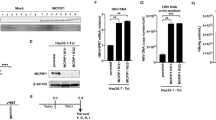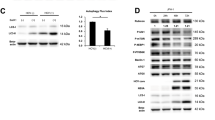Abstract
Hepatitis B virus (HBV) can cause chronic hepatitis B, which may lead to cirrhosis and liver cancer. Type I interferon (IFN) is an approved drug for the treatment of chronic hepatitis B. However, the fundamental mechanisms of antiviral action by type I IFN and the downstream signaling pathway are unclear. TRIM25 is an IFN-stimulated gene (ISG) that has an important role in RIG-I ubiquitination and activation. Whether TRIM25 is induced in liver cells by type I IFN to mediate anti-HBV function remains unclear. Here we report that interleukin-27 (IL-27) has a critical role in IFN-induced TRIM25 upregulation. TRIM25 induction requires both STAT1 and STAT3. In TRIM25 knockout HepG2 cells, type I IFN production was consistently attenuated and HBV replication was increased, whereas overexpression of TRIM25 in HepG2 cells resulted in elevated IFN production and reduced HBV replication. More interestingly, we found that TRIM25 expression was downregulated in HBV patients and the addition of serum samples from HBV patients could inhibit TRIM25 expression in HepG2 cells, suggesting that HBV might have involved a mechanism to inhibit antiviral ISG expression and induce IFN resistance. Collectively, our results demonstrate that type I IFN -induced TRIM25 is an important factor in inhibiting HBV replication, and the IFN-IL-27-TRIM25 axis may represent a new target for treating HBV infection.
This is a preview of subscription content, access via your institution
Access options
Subscribe to this journal
Receive 12 digital issues and online access to articles
$119.00 per year
only $9.92 per issue
Buy this article
- Purchase on Springer Link
- Instant access to full article PDF
Prices may be subject to local taxes which are calculated during checkout








Similar content being viewed by others
References
Mutimer DJ, Lok A . Management of HBV- and HCV-induced end stage liver disease. Gut 2012; 61 (Suppl 1): i59–i67.
Ivashkiv LB, Donlin LT . Regulation of type I interferon responses. Nat Rev Immunol 2014; 14: 36–49.
Liu SY, Sanchez DJ, Aliyari R, Lu S, Cheng G . Systematic identification of type I and type II interferon-induced antiviral factors. Proc Natl Acad Sci USA 2012; 109: 4239–4244.
Liu SY, Aliyari R, Chikere K, Li G, Marsden MD, Smith JK et al. Interferon-inducible cholesterol-25-hydroxylase broadly inhibits viral entry by production of 25-hydroxycholesterol. Immunity 2013; 38: 92–105.
Platanias LC . Mechanisms of type-I- and type-II-interferon-mediated signalling. Nat Rev Immunol 2005; 5: 375–386.
Rusinova I, Forster S, Yu S, Kannan A, Masse M, Cumming H et al. Interferome v2.0: an updated database of annotated interferon-regulated genes. Nucleic Acids Res 2013; 41 (Database issue): D1040–D1046.
Iyer SS, Ghaffari AA, Cheng G . Lipopolysaccharide-mediated IL-10 transcriptional regulation requires sequential induction of type I IFNs and IL-27 in macrophages. J Immunol 2010; 185: 6599–6607.
Yang CH, Wei L, Pfeffer SR, Du Z, Murti A, Valentine WJ et al. Identification of CXCL11 as a STAT3-dependent gene induced by IFN. J Immunol 2007; 178: 986–992.
Stumhofer JS, Laurence A, Wilson EH, Huang E, Tato CM, Johnson LM et al. Interleukin 27 negatively regulates the development of interleukin 17-producing T helper cells during chronic inflammation of the central nervous system. Nat Immunol 2006; 7: 937–945.
Hunter CA . New IL-12-family members: IL-23 and IL-27, cytokines with divergent functions. Nat Rev Immunol 2005; 5: 521–531.
Guo B, Chang EY, Cheng G . The type I IFN induction pathway constrains Th17-mediated autoimmune inflammation in mice. J Clin Invest 2008; 118: 1680–1690.
Stumhofer JS, Silver JS, Laurence A, Porrett PM, Harris TH, Turka LA et al. Interleukins 27 and 6 induce STAT3-mediated T cell production of interleukin 10. Nat Immunol 2007; 8: 1363–1371.
Basset L, Chevalier S, Danger Y, Arshad MI, Piquet-Pellorce C, Gascan H et al. Interleukin-27 and IFNgamma regulate the expression of CXCL9, CXCL10, and CXCL11 in hepatitis. J Mol Med 2015; 93: 1355–1367.
Torok M, Etkin LD . Two B or not two B? Overview of the rapidly expanding B-box family of proteins. Differentiation 2001; 67: 63–71.
Ozato K, Shin DM, Chang TH, Morse HC 3rd . TRIM family proteins and their emerging roles in innate immunity. Nat Rev Immunol 2008; 8: 849–860.
Rajsbaum R, Garcia-Sastre A, Versteeg GA . TRIMmunity: the roles of the TRIM E3-ubiquitin ligase family in innate antiviral immunity. J Mol Biol 2014; 426: 1265–1284.
Versteeg GA, Rajsbaum R, Sanchez-Aparicio MT, Maestre AM, Valdiviezo J, Shi M et al. The E3-ligase TRIM family of proteins regulates signaling pathways triggered by innate immune pattern-recognition receptors. Immunity 2013; 38: 384–398.
Uchil PD, Hinz A, Siegel S, Coenen-Stass A, Pertel T, Luban J et al. TRIM protein-mediated regulation of inflammatory and innate immune signaling and its association with antiretroviral activity. J Virol 2013; 87: 257–272.
Yang C, Zhao X, Sun D, Yang L, Chong C, Pan Y et al. Interferon alpha (IFNalpha)-induced TRIM22 interrupts HCV replication by ubiquitinating NS5A. Cell Mol Immunol 2016; 13: 94–102.
Zhang S, Guo JT, Wu JZ, Yang G . Identification and characterization of multiple TRIM proteins that inhibit hepatitis B virus transcription. PLoS One 2013; 8: e70001.
Gack MU, Shin YC, Joo CH, Urano T, Liang C, Sun L et al. TRIM25 RING-finger E3 ubiquitin ligase is essential for RIG-I-mediated antiviral activity. Nature 2007; 446: 916–920.
Tan G, Niu J, Shi Y, Ouyang H, Wu ZH . NF-kappaB-dependent microRNA-125b up-regulation promotes cell survival by targeting p38alpha upon ultraviolet radiation. J Biol Chem 2012; 287: 33036–33047.
Tan G, Shi Y, Wu ZH . MicroRNA-22 promotes cell survival upon UV radiation by repressing PTEN. Biochem Biophys Res Commun 2012; 417: 546–551.
Stremlau M, Owens CM, Perron MJ, Kiessling M, Autissier P, Sodroski J . The cytoplasmic body component TRIM5alpha restricts HIV-1 infection in Old World monkeys. Nature 2004; 427: 848–853.
Gao B, Duan Z, Xu W, Xiong S . Tripartite motif-containing 22 inhibits the activity of hepatitis B virus core promoter, which is dependent on nuclear-located RING domain. Hepatology 2009; 50: 424–433.
Sato S, Li K, Kameyama T, Hayashi T, Ishida Y, Murakami S et al. The RNA sensor RIG-I dually functions as an innate sensor and direct antiviral factor for hepatitis B virus. Immunity 2015; 42: 123–132.
Teles RM, Kelly-Scumpia KM, Sarno EN, Rea TH, Ochoa MT, Cheng G et al. IL-27 Suppresses antimicrobial activity in human leprosy. J Invest Dermatol 2015; 135: 2410–2417.
Yoshimura T, Takeda A, Hamano S, Miyazaki Y, Kinjyo I, Ishibashi T et al. Two-sided roles of IL-27: induction of Th1 differentiation on naive CD4+ T cells versus suppression of proinflammatory cytokine production including IL-23-induced IL-17 on activated CD4+ T cells partially through STAT3-dependent mechanism. J Immunol 2006; 177: 5377–5385.
Bender H, Wiesinger MY, Nordhoff C, Schoenherr C, Haan C, Ludwig S et al. Interleukin-27 displays interferon-gamma-like functions in human hepatoma cells and hepatocytes. Hepatology 2009; 50: 585–591.
Xu F, Song H, Li N, Tan G . HBsAg blocks TYPE I IFN induced up-regulation of A3G through inhibition of STAT3. Biochem Biophys Res Commun 2016; 473: 219–223.
Levy DE, Lee CK . What does Stat3 do? J Clin Invest 2002; 109: 1143–1148.
Wang WB, Levy DE, Lee CK . STAT3 negatively regulates type I IFN-mediated antiviral response. J Immunol 2011; 187: 2578–2585.
Ho HH, Ivashkiv LB . Role of STAT3 in type I interferon responses. Negative regulation of STAT1-dependent inflammatory gene activation. J Biol Chem 2006; 281: 14111–14118.
Wu J, Meng Z, Jiang M, Pei R, Trippler M, Broering R et al. Hepatitis B virus suppresses toll-like receptor-mediated innate immune responses in murine parenchymal and nonparenchymal liver cells. Hepatology 2009; 49: 1132–1140.
Liu S, Peng N, Xie J, Hao Q, Zhang M, Zhang Y et al. Human hepatitis B virus surface and e antigens inhibit major vault protein signaling in interferon induction pathways. J Hepatol 2015; 62: 1015–1023.
Acknowledgements
This work was supported in part by the National Natural Science Foundation, China, Jilin Provincial Science and Technology Department of the Youth Fund Project, and Jilin University Bethune training program (grant no. 81401290, 20160520161JH, 470110000456 to GT). CAMS Initiative for Innovative Medicine (no. CAMS-I2M) to FXQ and GC.
Author information
Authors and Affiliations
Corresponding authors
Ethics declarations
Competing interests
The authors declare no conflict of interest.
Additional information
Supplementary Information for this article can be found on the Cellular & Molecular Immunology website
Rights and permissions
About this article
Cite this article
Tan, G., Xiao, Q., Song, H. et al. Type I IFN augments IL-27-dependent TRIM25 expression to inhibit HBV replication. Cell Mol Immunol 15, 272–281 (2018). https://doi.org/10.1038/cmi.2016.67
Received:
Revised:
Accepted:
Published:
Issue Date:
DOI: https://doi.org/10.1038/cmi.2016.67
Keywords
This article is cited by
-
Swine acute diarrhea syndrome coronavirus nucleocapsid protein antagonizes the IFN response through inhibiting TRIM25 oligomerization and functional activation of RIG-I/TRIM25
Veterinary Research (2024)
-
Interleukin-22 facilitates the interferon-λ-mediated production of tripartite motif protein 25 to inhibit replication of duck viral hepatitis A virus type 1
Veterinary Research (2023)
-
Triple motif proteins 19 and 38 correlated with treatment responses and HBsAg clearance in HBeAg-negative chronic hepatitis B patients during peg-IFN-α therapy
Virology Journal (2023)
-
Emerging Therapies for Chronic Hepatitis B and the Potential for a Functional Cure
Drugs (2023)
-
TRIM proteins in hepatocellular carcinoma
Journal of Biomedical Science (2022)



